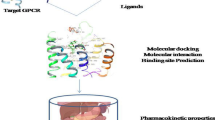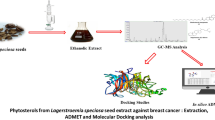Abstract
Breast cancer is one of the leading cause of cancer related deaths in women, worldwide. In Malaysia, it is the most common cancer, where 1 in 19 Malaysian women are diagnosed with breast cancer. The incidence rate is increasing because of the lack of specific symptoms in the early stage of disease leading to delay in diagnosis. Unfortunately, recently used treatments such as chemotherapeutic, surgery and radiation therapies have not been fully effective against breast cancer. Therefore, there is a need of developing new approaches for the treatment of breast cancer. In this regards, plant derived compounds have been identified as a class of promising anticancer agents in the quest for novel pharmaceutical compounds to built the new target protein, their simulation and interaction with phytocompounds. The molecular docking method has been explored for its binding affinity towards the site of interactions. The best binding affinity is chosen based on the lowest binding energy, total intermolecular energy and highest number of hydrogen bonds to target the phytocompounds. Thus, the aim of this chapter is to focus on the potentiality of the phytocompound based drug discovery for the treatment of breast cancer.
Access this chapter
Tax calculation will be finalised at checkout
Purchases are for personal use only
Similar content being viewed by others
References
Abu-Dahab R, Afifi F (2007) Antiproliferative activity of selected medicinal plants of Jordan against a breast adenocarcinoma cell line (MCF7). Sci Pharm 75:121–136
Alkhalaf M (2007) Resveratrol-induced growth inhibition in MDA-MB-231 breast cancer cells is associated with mitogen-activated protein kinase signaling and protein translation. Eur J Cancer Prev 16:334–341
Al-Lazikani B, Jung J, Xiang Z, Honig B (2001) Protein structure prediction. Curr Opin Chem Biol 5:51–56
Armania N, Yazan LS, Ismail IS, Foo JB, Tor YS, Ishak N, Ismail M (2013) Dillenia suffruticosa extract inhibits proliferation of human breast cancer cell lines (MCF-7 and MDA-MB-231) via induction of G2/M arrest and apoptosis. Molecules 18:13320–13339
Cavalier E, Chakravarti D, Guttenplan J (2006) Catechol estrogenquinones as initiators of breast and other human cancers: implications for biomarkers of susceptibility and cancer prevention. Biochim Biophys Acta 1766:63–78
Charoensin S (2014) Antioxidant and anticancer activities of Moringa oleifera leaves. J Med Plants Res 8:318–325
Chryssanthi DG, Lamari FN, Iatrou G, Pylara A, Karamanos NK, Cordopatis P (2007) Inhibition of breast cancer cell proliferation by style constituents of different Crocus species. Anticancer Res 27:357–362
Cragg GM, Newman DJ (2005) Plants as a source of anti-cancer agents. J Ethnopharmacol 100:72–79
Devi SP, Kumaria S, Rao SR, Tandon P (2016) Carnivorous plants as a source of potent bioactive compound: Naphthoquinones. Trop Plant Biol 9:267–279
Dunning AM, Healey CS, Pharoah PD, Teare MD, Ponder BA, Easton DF (1999) A systematic review of genetic polymorphisms and breast cancer risk. Cancer Epidemiol Biomark Prev 8:843–854
Elufioye TO, Abdul AA, Moody JO (2017) Cytotoxicity studies of the extracts, fractions, and isolated compound of Pseudocedrela kotschyi on cervical cancer (HeLa), breast cancer (MCF-7) and skeletal muscle cancer (RD) cells. Pharm Res 9:46–50
García-Rivera D, Delgado R, Bougarne N, Haegeman G, Berghe WV (2011) Gallic acid indanone and mangiferinxanthone are strong determinants of immunosuppressive anti-tumour effects of Mangifera indica L. bark in MDA-MB231 breast cancer cells. Cancer Lett 305:21–31
Gazala NK, Michael A, Gorin DR, Pan Q, Bao LW, Wu ZF, Robert AN, Polus AD, Yang P, Lansky EP, Merajver SD (2009) Pomegranate fruit extract impairs invasion and motility in human breast cancer. Integr Cancer Ther 8:242–253
Hawkins LK, Hermiston T (2001) Gene delivery from the E3 region of replicating human adenovirus: evaluation of the E3B region. Gene Ther 8:1142–1148
Hui C, Bin Y, Xiaoping Y, Long Y, Chunye C, Mantian M (2010) Anticancer activities of an anthocyanin-rich extract from black rice against breast cancer cells in vitro and in vivo. Nutr Cancer 62:1128–1136
Jung HA, Su BN, Keller WJ, Mehta RG, Kinghorn AD (2006) Antioxidant xanthones from the pericarp of Garcinia mangostana (Mangosteen). J Agric Food Chem 54:2077–2082
Jurenka JS (2009) Anti-inflammatory properties of curcumin, a major constituent of Curcuma longa: a review of preclinical and clinical research. Altern Med Rev 14:141–153
Kim WK, Kim JH, Jeong DH, Chun YH, Kim SH, Cho KJ, Chang MJ (2011) Radish (Raphanus sativus L.) leaf ethanol extract inhibits protein and mRNA expression of ErbB2 and ErbB3 in MDA-MB-231 human breast cancer cells. Nutr Res Pract 5:288–293
Kishore K, Chiruvella PK, Choudhary B, Joy O, Raghavan SC (2010) Methyl angolensate from callus of Indian redwood induces cytotoxicity in human breast cancer cells. Int J Biomed Sci 6:182–194
Laurie AT, Jackson RM (2005) Q-SiteFinder: an energy-based method for the prediction of protein-ligand binding sites. Bioinformatics 21:1908–1916
Le Corre L, Chalabi N, Delort L, Bignon YJ, Bernard-Gallon DJ (2005) Resveratrol and breast cancer chemoprevention: molecular mechanisms. Mol Nutr Food Res 49:462–471
Lee HS, Seo EY, Kang NE, Kim WK (2008) [6]-Gingerol inhibits metastasis of MDA-MB-231 human breast cancer cells. J Nutr Biochem 19:313–319
Liu J, Lin RI, John AM (1992) Inhibition of 7,12 dimethylbenz[a]anthracene-induced mammary tumors and DNA adducts by garlic powder. Carcinogenesis 13:1847–1851
Macarron R (2006) Critical review of the role of HTS in drug discovery. Drug Discov Today 11:277–279
Maliyakkal N, Udupa N, Pai KSR, Rangarajan A (2013) Cytotoxic and apoptotic activities of extracts of Withania somnifera and Tinospora cordifolia in human breast cancer cells. Int J Appl Res Nat Prod 6:1–10
Mantle D, Lennard TW, Pickering AT (2000) Therapeutic applications of medicinal plants in the treatment of breast cancer: a review of their pharmacology, efficacy and tolerability. Adverse Drug React Toxicol Rev 19:223–240
Medical News Today (2015) What is breast cancer. What causes breast cancer. http://www.medicalnewstoday.com/articles/37136.php. Assessed on 28 Nov 2017
Moghadamtousi SZ, Fadaeinasab M, Nikzad S, Mohan G, Ali HM, Kadir HA (2015) Annona muricata (Annonaceae): a review of its traditional uses, isolated acetogenins and biological activities. Int J Mol Sci 16:15625–15658
Othman FGM, Peng SLT, Rahmat A, Fakurazi S, Pei CP (2011) Extract of Azadirachta indica (Neem) leaf induces apoptosis in 4T1 breast cancer BALB/c mice. Cell J 13:107–116
Rabi T, Ramachandran, Fonseca HB, PKR N, Alamo A, Escalon SME (2003) Novel drug amooranin induces apoptosis through caspase activity in human breast carcinoma cell lines. Breast Cancer Res Treat 80:321–330
Rinaldi MV, Díaz IE, Suffredini IB, Moreno PR (2017) Alkaloids and biological activity of beribá (Annona hypoglauca). Rev Bras Farm 27:77–83
Sanchez R, Pieper U, Melo F, Eswar N, Marti-Renom MA, Madhusudhan MS, Mirkovic N, Sali A (2000) Protein structure modeling for structural genomics. Nat Struct Biol 7:986–990
Sanner MF (1999) Python: a programming language for software integration and development. J Mol Graph Model 17:57–61
Sathuvan M, Vignesh A, Thangam R, Palani P, Rengasamy R, Murugesan K (2012) In vitro antioxidant and anticancer potential of bark of Costus pictus D. Don. Asian Pac J Trop Biomed 2:S741–S749
Sergeev IN, Li S, Colby J, Ho CT, Dushenkov S (2006) Polymethoxylated flavones induce Ca2+ mediated apoptosis in breast cancer cells. Life Sci 80:245–253
Sharoni Y, Danilenko M, Levy J (2000) Molecular mechanisms for the anticancer activity of the carotenoid lycopene. Drug Dev Res 50:448–456
Sukardiman H, Widyawaruyanti A, Sismindari ZNC (2007) Apoptosis inducing effect of andrographolide on TD-47 human breast cancer cell line. Afr J Tradit Complement Altern Med 4:345–351
Sunamura M, Yatsuoka T, Motoi F, Duda DG, Kimura M, Abe T, Yokoyama T, Inoue H, Oonuma M, Takeda K, Matsuno S (2002) Gene therapy for pancreatic cancer based on geneticalterization of the disease. J Hepatobiliary Pancreat Surg 9:32–38
Tandrasasmita OM, Lee JS, Baek SH, Tjandrawinata RR (2010) Induction of cellular apoptosis in human breast cancer by DLBS1425, a Phaleria macrocarpa compound extract, via down-regulation of PI3-kinase/AKT pathway. Cancer Biol Ther 10:814–823
van der Spoel D, Lindahl E, Hess B, Groenhof G, Mark AE, Berendsen HJC (2005) GROMACS: fast, flexible, and free. J Comput Chem 26:1701–1718
van Gunsteren WF, Billeter SR, Eising AA, Hünenberger PH, Krüger P, Mark AE, Scott WRP, Tironi IG (1996) Biomolecular simulation: the GROMOS96 manual and user guide, VdfHochschulverlag AG an der ETH Zürich, Zürich, Switzerland, pp 1–1042
WHO (2014) Cancer factsheet. http://www.who.int/mediacentre/factsheets/fs297/en/. Assessed on 21 Nov 2017
Author information
Authors and Affiliations
Corresponding author
Editor information
Editors and Affiliations
Rights and permissions
Copyright information
© 2018 Springer Nature Singapore Pte Ltd.
About this chapter
Cite this chapter
Elengoe, A., Hamdan, S. (2018). Computational Approach Towards Exploring Interaction of Target Protein-Phytocompounds in Drug Development for Breast Cancer. In: Akhtar, M., Swamy, M. (eds) Anticancer Plants: Mechanisms and Molecular Interactions. Springer, Singapore. https://doi.org/10.1007/978-981-10-8417-1_5
Download citation
DOI: https://doi.org/10.1007/978-981-10-8417-1_5
Published:
Publisher Name: Springer, Singapore
Print ISBN: 978-981-10-8416-4
Online ISBN: 978-981-10-8417-1
eBook Packages: Biomedical and Life SciencesBiomedical and Life Sciences (R0)




